Apple's patent slap on Android & HTC products may be the tip of the legal iceberg

In the world of legal rights, whether patent or copyrights, the owner must defend its rights or lose them. According to Apple's patent complaint filed on Tuesday, Cupertino has other actions already moving along in the courts.
On Page 24 of the complaint in the section titled Related Litigation, Apple mentions a number of other legal moves:
82. At present, the '705, '263, '136, '187, and RDE '486 patents are the subject of an investigation (instituted on February 24, 2010) by the United States International Trade Commission in In the Matter of Certain Mobile Communications and Computer Devices and Components Thereof, Investigation No. 337-TA-704. At present, these patents are also the subject of counterclaims by Apple (filed on February 24, 2010) to a patent infringement complaint brought by the Respondent Nokia in Nokia Corp. v. Apple Inc. (On December 29, 2009), Civil Action 09-1002-GMS, currently pending in the District of Delaware.
83. Concurrent with the filing of this complaint, Complaintants will file a civil action in the United States District Court for the District of Delaware accusing the respondents of infringing the asserted patents.
Apple is countersuing Nokia and hittlng at Google over patents. The latter complaint can be found on Scribid here.
Meanwhile over at Betanews, there's an interesting rundown of the complaint that concludes with an analysis of a 2009 blog post by programmer Koushik Dutta that compared Android Dalvik virtual machine's "inefficient" handling of processes with the open-source Mono.
Dutta's explanation, in summary, appears to contrast the architecture of operating systems that adopt the principle of minimizing their memory footprints (Android) against those that take the more direct approach of suspending some apps for others to run (iPhone). Here's where it is important to note that Apple does not appear to be defending its iPhone, but rather technologies that are actually more relevant to MacOS.
Nevertheless, it may be the very inefficiencies that Dutta pointed out, that could be Android's saving grace in its upcoming battle against Apple. If Android is indeed as inefficient as some say it is, it may not be violating anyone's patent at all.
I don't buy it, but that will be for the court to decide. Certainly, Apple's actions have been in the works for a long while. And the company's hardware and software gurus have had a good long while to break down Android's memory handling.
Perhaps there's a lesson here in Apple's legal history. After Apple sued Microsoft over the look-and-feel of the Mac OS in 1988 — the copyright filing that Apple eventually lost — Xerox dogpiled with a lawsuit claiming that Apple had stolen its Star GUI and used its interface elements in the Lisa and Mac OSes. And Apple did. Steve Jobs and other members of the development teams made a field trip to PARC and were shown the Star computers.
However, this case was dismissed because too long of a time had passed between the release of the Mac and the litigation. The statute of limitations had expired.
Apple appears to have learned that timing lesson and appears to be suing and countersuing early and often. This may be only the beginning of Apple's protection of its iTurf.
Note: The button at the top of the story is from my personal collection. I received it at a Berkeley Macintosh Users Group meeting on the Cal campus in 1988 in the days following Apple's copyright suit against Microsoft.
